会议论文相关报告英文版.pptx
英文文献报告PPT模板

5
Our Company
adLorem ipsum dolor sit amet, consectetur
adipiscing elit.
CONTENT
4
Lorem ipsum dolor sit amet, consectetur
adipiscing elit.
mauris, sed suscipit quam egestas nec.
2
OUR CONTENT
CONTENT
1
Lorem ipsum dolor sit amet, consectetur
adipiscing elit.
CONTENT
2
Lorem ipsum dolor sit amet, consectetur
Nulla euismod congue arcu quis feugiat. Phasellus porttitor felis mauris, sed suscipit quam egestas nec.
Our Company
Nulla consequat massa quis enim. Donec pede justo, fringilla vel, aliquet nec, vulputate eget, arcu. In enim justo, rhoncus ut, imperdiet a, venenatis vitae, justo. Nullam dictum felis eu pede mollis pretium. Integer tincidunt. Cras dapibus. Vivamus elementum semper nisi. Aenean vulputate eleifend tellus. Aenean leo ligula, porttitor eu, consequat vitae, eleifend ac, enim. Aliquam lorem ante, dapibus in, viverra quis, feugiat a, tellus. Phasellus viverra nulla ut metus varius laoreet. Quisque rutrum. Aenean imperdiet. Etiam ultricies nisi vel augue. Curabitur ullamcorper ultricies nisi. Nam eget dui. Etiam rhoncus.
学术会议论文模板英文版

Paper Title (use style: paper title) Subtitle as needed (paper subtitle)Authors Name/s per 1st Affiliation (Author) FirstName Surname line 1 (of Affiliation): dept. name of organization line 2: name of organization, acronyms acceptableline 3: City, Countryline 4: e-mail address if desiredAuthors Name/s per 3rd Affiliation (Author)* FirstName Surname line 1 (of Affiliation): dept. name of organization line 2: name of organization, acronyms acceptableline 3: City, Country* Corresponding author: e-mail address if desired Authors Name/s per 2nd Affiliation (Author) FirstName Surname line 1 (of Affiliation): dept. name of organization line 2: name of organization, acronyms acceptableline 3: City, Countryline 4: e-mail address if desiredAuthors Name/s per 4th Affiliation (Author) FirstName Surname line 1 (of Affiliation): dept. name of organization line 2: name of organization, acronyms acceptableline 3: City, Countryline 4: e-mail address if desiredAbstract—This electronic document is a “live” t emplate. The various components of your paper [title, text, heads, etc.] are already defined on the style sheet, as illustrated by the portions given in this document. (Abstract)Keywords-component; formatting; style; styling; insert (key words)I.I NTRODUCTION (H EADING 1)This template, modified in MS Word 2003 and saved as “Word 97-2003 & 6.0/95 –RTF” for the PC, provides authors with most of the formatting specifications needed for preparing electronic versions of their papers. All standard paper components have been specified for three reasons: (1) ease of use when formatting individual papers, (2) automatic compliance to electronic requirements that facilitate the concurrent or later production of electronic products, and (3) conformity of style throughout a conference proceedings. Margins, column widths, line spacing, and type styles are built-in; examples of the type styles are provided throughout this document and are identified in italic type, within parentheses, following the example. Some components, such as multi-leveled equations, graphics, and tables are not prescribed, although the various table text styles are provided. The formatter will need to create these components, incorporating the applicable criteria that follow.II.E ASE OF U SEA.Selecting a Template (Heading 2)First, confirm that you have the correct template for your paper size. This template has been tailored for output on the US-letter paper size. If you are using A4-sized paper, please close this file and download the file for “MSW_A4_format”.B.Maintaining the Integrity of the SpecificationsThe template is used to format your paper and style the text. All margins, column widths, line spaces, and text fonts are prescribed; please do not alter them. You may note peculiarities. For example, the head margin in this template measures proportionately more than is customary. This measurement and others are deliberate, using specifications that anticipate your paper as one part of the entire proceedings, and not as an independent document. Please do not revise any of the current designations.III.P REPARE Y OUR P APER B EFORE S TYLING Before you begin to format your paper, first write and save the content as a separate text file. Keep your text and graphic files separate until after the text has been formatted and styled. Do not use hard tabs, and limit use of hard returns to only one return at the end of a paragraph. Do not add any kind of pagination anywhere in the paper. Do not number text heads-the template will do that for you.Finally, complete content and organizational editing before formatting. Please take note of the following items when proofreading spelling and grammar:A.Abbreviations and AcronymsDefine abbreviations and acronyms the first time they are used in the text, even after they have been defined in the abstract. Abbreviations such as IEEE, SI, MKS, CGS, sc, dc, and rms do not have to be defined. Do not use abbreviations in the title or heads unless they are unavoidable.B.Units•Use either SI (MKS) or CGS as primary units. (SI units are encouraged.) English units may be used assecondary units (in parentheses). An exception wouldbe the use of English units as identifiers in trade, suchas “3.5-inch disk drive”.•Avoid combining SI and CGS units, such as current in amperes and magnetic field in oersteds. This oftenleads to confusion because equations do not balancedimensionally. If you must use mixed units, clearlyIdentify applicable sponsor/s here. (sponsors)state the units for each quantity that you use in anequation.•Do not mix complete spellings and abbreviations of units: “Wb/m2” or “webers per square meter”, not“webers/m2”. Spell out units when they appear in text:“. . . a few henries”, not “. . . a few H”.•Use a zero before decimal points: “0.25”, not “.25”.Use “cm3”, not “cc”. (bullet list)C.EquationsThe equations are an exception to the prescribed specifications of this template. You will need to determine whether or not your equation should be typed using either the Times New Roman or the Symbol font (please no other font). To create multileveled equations, it may be necessary to treat the equation as a graphic and insert it into the text after your paper is styled.Number equations consecutively. Equation numbers, within parentheses, are to position flush right, as in (1), using a right tab stop. To make your equations more compact, you may use the solidus ( / ), the exp function, or appropriate exponents. Italicize Roman symbols for quantities and variables, but not Greek symbols. Use a long dash rather than a hyphen for a minus sign. Punctuate equations with commas or periods when they are part of a sentence, as inα + β = χ. (1)Note that the equation is centered using a center tab stop. Be sure that the symbols in your equation have been defined before or immediately follow ing the equation. Use “(1)”, not “Eq. (1)” or “equation (1)”, except at the beginning of a sentence: “Equation (1) is . . .”D.Some Common Mistakes•The word “data” is plural, not singular.•The subscript for the permeability of vacuum μ0, and other common scientific constants, is zero withsubscript formatting, not a lowercase letter “o”.•In American English, commas, semi-/colons, periods, question and exclamation marks are located withinquotation marks only when a complete thought orname is cited, such as a title or full quotation. Whenquotation marks are used, instead of a bold or italictypeface, to highlight a word or phrase, punctuationshould appear outside of the quotation marks. Aparenthetical phrase or statement at the end of asentence is punctuated outside of the closingparenthesis (like this). (A parenthetical sentence ispunctuated within the parentheses.)• A graph within a graph is an “inset”, not an “insert”.The word alternatively is preferred to the word“alternately” (unless you really mean something thatalternates).•Do not use the word “essentially” to mean “approximately” or “effectively”.•In your paper title, if the words “that uses” can accurately replace the word “using”, capitalize the “u”;if not, keep using lower-cased.•Be aware of the different meanings of the homophones “affect” and “effect”, “complement” and “compliment”,“discreet” and “discrete”, “principal” and “principle”.•Do not confuse “imply” and “infer”.•The prefix “non” is not a word; it should be joined to the word it modifies, usually without a hyphen.•There is no period after the “et” in the Latin abbreviation “et al.”.•The abbreviation “i.e.” means “that is”, and the abbreviation “e.g.” means “for example”.An excellent style manual for science writers is [7].IV.U SING THE T EMPLATEAfter the text edit has been completed, the paper is ready for the template. Duplicate the template file by using the Save As command, and use the naming convention prescribed by your conference for the name of your paper. In this newly created file, highlight all of the contents and import your prepared text file. You are now ready to style your paper; use the scroll down window on the left of the MS Word Formatting toolbar.A.Authors and AffiliationsThe template is designed so that author affiliations are not repeated each time for multiple authors of the same affiliation. Please keep your affiliations as succinct as possible (for example, do not differentiate among departments of the same organization). This template was designed for two affiliations.1)For author/s of only one affiliation (Heading 3): To change the default, adjust the template as follows.a)Selection (Heading 4): Highlight all author and affiliation lines.b)Change number of columns: Select the Columns icon from the MS Word Standard t oolbar and then select “1 Column” from the selection palette.c)Deletion: Delete the author and affiliation lines for the second affiliation.d)For author/s of more than two affiliations: To change the default, adjust the template as follows.e)Selection: Highlight all author and affiliation lines.f)Change number of columns: Select the “Columns” icon from the MS Word Standard toolbar and then select “1 Column” from the selection palette.g)Highlight author and affiliation lines of affiliation 1 and copy this selection.h)Formatting: Insert one hard return immediately after the last character of the last affiliation line. Then paste down the copy of affiliation 1. Repeat as necessary for each additional affiliation.i)Reassign number of columns: Place your cursor to the right of the last character of the last affiliation line of an even numbered affiliation (e.g., if there are five affiliations, place your cursor at end of fourth affiliation). Drag the cursor up to highlight all of the above author and affiliation lines. Go to Column icon and select “2 Columns”. If you have an odd number of affiliations, the final affiliation will be centered on the page; all previous will be in two columns.B.Identify the HeadingsHeadings, or heads, are organizational devices that guide the reader through your paper. There are two types: component heads and text heads.Component heads identify the different components of your paper and are not topically subordinate to each other. Examples include Acknowledgments and References and, for these, the correct style to use is “Heading 5”. Use “figure caption” foryour Figure captions, and “table head” for your table title. Run-in heads, such as “Abstract”, will require you to apply a style (in this case, italic) in addition to the style provided by the drop down menu to differentiate the head from the text.Text heads organize the topics on a relational, hierarchical basis. For example, the paper title is the primary text head because all subsequent material relates and elaborates on this one topic. If there are two or more sub-topics, the next level head (uppercase Roman numerals) should be used and, conversely, if there are not at least two sub-topics, then no subheads should be introduced. Styles named “Heading 1”, “Heading 2”, “Heading 3”, and “Heading 4” are prescribed.C.Figures and Tables1)Positioning Figures and Tables: Place figures and tables at the top and bottom of columns. Avoid placing them in the middle of columns. Large figures and tables may span across both columns. Figure captions should be below the figures; table heads should appear above the tables. Insert figures and tables after they are cited in the text. Use the abbreviation “Fig. 1”, even at the beginning of a sentence.TABLE I. T ABLE T YPE S TYLESa. Sample of a Table footnote. (Table footnote)Figure 1. Example of a figure caption. (figure caption) Figure Labels: Use 8 point Times New Roman for Figure labels. Use words rather than symbols or abbreviations when writing Figure axis labels to avoid confusing the reader. As anexample, write the quantity “Magnetization”, or “Magnetization, M”, not just “M”. If including units in the label, present them within parentheses. Do not label axes only with units. In the example, write “Magnetization (A/m)” or “Magnetization {A[m(1)]}”, not just “A/m”. Do not label axes with a ratio of quantities and units. For example, write “Temperature (K)”, not “Temperature/K”.V. Conclusions(Heading 5)A CKNOWLEDGMENTThe pre ferred spelling of the word “acknowledgment” in America is without an “e” after the “g”. Avoid the stilted expression, “One of us (R. B. G.) thanks . . .” Instead, try “R.B. G. thanks”. Put sponsor acknowledgments in the unnum-bered footnote on the first page.R EFERENCES(Note: ①The authors of the references cited in the article should not be of one nationality only. They should be from three or more; ②It is not possible to have less than five references.) The template will number citations consecutively within brackets [1]. The sentence punctuation follows the bracket [2]. Refer simply to the reference number, as in [3]—do not use “Ref. [3]” or “reference [3]” except at the beginning of a sentence: “Reference [3] was the first . . .”Number footnotes separately in superscripts. Place the actual footnote at the bottom of the column in which it was cited. Do not put footnotes in the reference list. Use letters for table footnotes.Unless there are six authors or more give all authors' names; do not use “et al.”. Papers that ha ve not been published, even if they have been submitted for publication, should be cited as “unpublished” [4]. Papers that have been accepted for publication should be cited as “in press” [5]. Capitalize only the first word in a paper title, except for proper nouns and element symbols.For papers published in translation journals, please give the English citation first, followed by the original foreign-language citation [6].[1]G. Eason, B. Noble, and I. N. Sneddon, “On certain integrals ofLipschitz-Hankel t ype involving products of Bessel functions,” Phil.Trans. Roy. Soc. London, vol. A247, pp. 529–551, April 1955.(references)[2]J. Clerk Maxwell, A Treatise on Electricity and Magnetism, 3rd ed., vol.2. Oxford: Clarendon, 1892, pp.68–73.[3]I. S. Jacobs and C. P. Bean, “Fine particles, thin films and exchangeanisotropy,” in Magnetism, vol. III, G. T. Rado and H. Suhl, Eds. New York: Academic, 1963, pp. 271–350.[4]K. Elissa, “Title of paper if known,” unpublished.[5]R. Nicole, “Title of paper with only first word capitalized,” J. NameStand. Abbrev., in press. [6]Y. Yorozu, M. Hirano, K. Oka, and Y. Tagawa, “Electron spectroscopystudies on magneto-optical media and plastic substrate interface,” IEEE Transl. J. Magn. Japan, vol. 2, pp. 740–741, August 1987 [Digests 9th Annual Conf. Magnetics Japan, p. 301, 1982].[7]M. Young, The Technical Writer's Handbook. Mill Valley, CA:University Science, 1989.。
研究报告ppt英语版
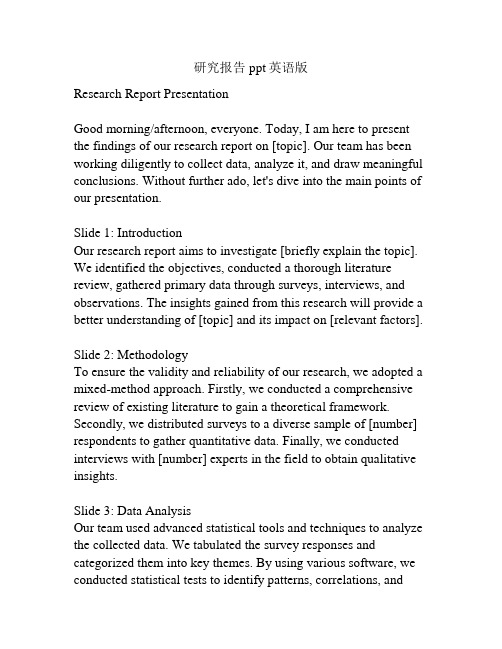
研究报告ppt英语版Research Report PresentationGood morning/afternoon, everyone. Today, I am here to present the findings of our research report on [topic]. Our team has been working diligently to collect data, analyze it, and draw meaningful conclusions. Without further ado, let's dive into the main points of our presentation.Slide 1: IntroductionOur research report aims to investigate [briefly explain the topic]. We identified the objectives, conducted a thorough literature review, gathered primary data through surveys, interviews, and observations. The insights gained from this research will provide a better understanding of [topic] and its impact on [relevant factors]. Slide 2: MethodologyTo ensure the validity and reliability of our research, we adopted a mixed-method approach. Firstly, we conducted a comprehensive review of existing literature to gain a theoretical framework. Secondly, we distributed surveys to a diverse sample of [number] respondents to gather quantitative data. Finally, we conducted interviews with [number] experts in the field to obtain qualitative insights.Slide 3: Data AnalysisOur team used advanced statistical tools and techniques to analyze the collected data. We tabulated the survey responses and categorized them into key themes. By using various software, we conducted statistical tests to identify patterns, correlations, andsignificant relationships between variables. The interviews were transcribed and coded to extract key themes and insights.Slide 4: FindingsAfter analyzing the data, we identified several key findings regarding [topic]. These findings include [mention the most significant findings]. For example, we found that [state a key finding and its implications]. Additionally, we discovered that [another key finding and its implications].Slide 5: DiscussionIn this section, we will discuss the implications of our findings. We will analyze the data in the broader context of [topic]. We will explore the possible reasons for certain patterns, discuss the limitations of our research, and suggest areas for future research and improvement.Slide 6: ConclusionTo conclude our research report, we would like to emphasize that our findings provide valuable insights into the field of [topic]. The implications of our research can be applied to [relevant sectors or stakeholders]. We hope that our report serves as a foundation for further research and contributes to the knowledge on [topic]. Slide 7: Q&A SessionNow, I would be happy to answer any questions or address any concerns you may have regarding our research report.Slide 8: Thank YouFinally, I would like to express my gratitude to our team memberswho contributed their time, effort, and expertise to complete this research report. I would also like to thank our sponsors for their support and everyone present here for their attention. Thank you all for being a part of this presentation.In conclusion, our research report provides valuable insights into [topic]. Through our rigorous methodology, data analysis, and discussion, we aim to contribute to the existing knowledge in this field. Thank you once again, and I look forward to any questions or discussions.。
英文学术报告范例ppt课件
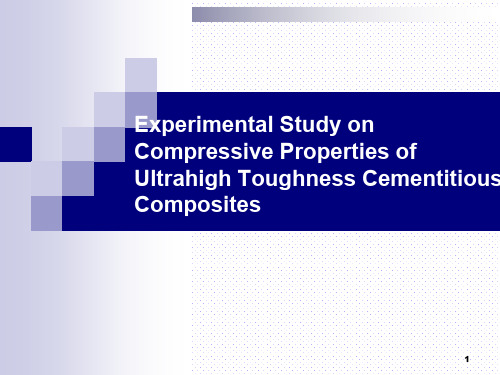
Experimental Program
Table 1. Specimen Information of Each Group
Test series Specimen shape
Specimen size/mm
UHTCC
Prism
40×40×160
Matrix
Prism
40×40×160
Specimen
number 9a 9a
Suffix representation
p40u p40m
5
Results
Comparison of compressive strength
Fig. 1. Comparison of prism compressive strength between UHTCC and matrix
0.2c
8
Comparison of stress-strain curves
The chart shows the comparison between the predictions and the test data of UHTCC
The predicted curves are obtained by using the experimental strain value at peak stress instead of the fixed value of 0.002.
c c3 c2
(c3
0.2c2
Байду номын сангаас
0.8
)
Strain hardening branch: c1 c2
c
Horizontal branch: c3 c
英文学术报告PPT课件

.
8
EVALUATION
A. Prediction Accuracy
The scatter plot in Fig shows the fitted score (as the χ-axis) and the user score (as the Υ-axis) for each rate pair and time interval test set
Accuracy of prediction
.
10
EVALUATION
B. Comparison to PESQ
1) Fixed Rate
Prediction error: SILK versus PESQ for fixed-rate tracks
For the fixed-rate comparison, we included tracks in both
.
5
PROPOSED MODEL
B. Variable-Rate Model
where the effect of change frequency is distributed to the logarithm term, and the effect of hr and lr is distributed to the two subroutines, SCALE() and SHIFT() .
LARGE-SCALE EXPERIMENT
EVALUATION CONCLUSION AND FUTURE WORK
.
2
Background
THE EFFECTIVE end-to-end transport of delay-sensitive voice data has long been a subject of study in multimedia networking.
会议论文相关报告(英文版)

会议论文相关报告(英文版)Title: The Impact of Virtual Meetings on Modern Conference CultureIntroduction:The advancement of technology has revolutionized all aspects of human life, including the way conferences are conducted. Traditional face-to-face meetings are gradually being replaced by virtual meetings, where participants can connect remotely through digital platforms. This report aims to analyze the impact of virtual meetings on modern conference culture by evaluating its advantages, disadvantages, and potential future developments. Advantages of Virtual Meetings:1. Accessibility and Flexibility:Virtual meetings provide unprecedented accessibility, enabling participants from different corners of the world to connect without the hassle of travel. This allows for increased diversity in terms of participants' geographical locations, making conferences more inclusive and globally representative. Moreover, virtual meetings offer flexibility in terms of timing and scheduling, accommodating participants across different time zones.2. Cost and Time Efficiency:By eliminating travel expenses and reducing the need for physical facilities, virtual meetings significantly cut down costs. Conference organizers can allocate their budget in more innovative ways, such as investing in the development of virtual platforms or inviting high-profile speakers. Additionally, participants save time and energy that would otherwise be spent on commuting or waiting atairports, allowing for increased productivity.3. Enhanced Networking Opportunities:Virtual meetings have developed various interactive features, enabling participants to engage in real-time discussions, exchange contact information, and collaborate on projects. Online chat rooms, breakout sessions, and virtual exhibition halls facilitate networking opportunities, connecting individuals who share common interests and promoting fruitful collaborations beyond the conference duration.Disadvantages of Virtual Meetings:1. Limited Human Interaction:One of the primary disadvantages of virtual meetings is the lack of face-to-face interaction, which can lead to reduced levels of engagement and connection among participants. Non-verbal cues and subtle communication nuances can be missed, potentially hindering effective collaboration and understanding. Additionally, participants may struggle to establish personal connections, as virtual interactions often lack the intimacy of in-person meetings.2. Technical Challenges:Virtual meetings heavily rely on internet connectivity and technological infrastructure. Unreliable network connections, software glitches, or hardware failures can disrupt the smooth flow of discussions and compromise the overall conference experience. This poses a significant challenge to event organizers, who need to ensure participants have access to stable technological resources.3. Reduced Spatial Experience:Virtual meetings lack the spatial experience offered by physical conferences. Participants do not have the opportunity to experience the ambiance, visual aesthetics, or the physical presence of others. This absence of a physical environment may diminish inspiration and creativity, limiting the overall impact of the conference. Future Developments and Recommendations:Virtual meetings have proved to be an effective alternative in times of crisis, such as the COVID-19 pandemic. As technology continues to advance, it is crucial to explore further developments that can address the limitations of virtual meetings. The integration of virtual reality (VR) and augmented reality (AR) technologies could potentially enhance the immersive experience, allowing participants to simulate physical interactions and replicate conference settings.Conclusion:Virtual meetings have emerged as a viable solution in the modern conference culture, providing accessibility, cost efficiency, and networking opportunities. However, challenges related to limited human interaction and technical issues must be addressed to further improve the effectiveness of virtual meetings. Combining technological advancements and creative solutions, virtual meetings have the potential to redefine the conference landscape and offer an engaging and inclusive environment for future participants.Additional Content:The impact of virtual meetings on modern conference culture has been significant and continues to evolve. As technology advances, virtual meetings are becoming more immersive, interactive, andrealistic. This section will explore further developments in virtual meeting technology, the implications for conference culture, and recommendations for optimizing the virtual conference experience.1. Evolution of Virtual Meeting Technology:a) Virtual Reality (VR): Virtual reality technology creates a simulated environment that participants can interact with using special headsets or devices. VR enables users to have a more immersive conference experience, by allowing them to navigate and interact with virtual spaces, avatars, and objects. This technology has the potential to revolutionize virtual conferences by providing a more realistic sense of presence and enhancing collaboration.b) Augmented Reality (AR): Augmented reality technology overlays digital content onto the real-world environment, often through the use of mobile devices or smart glasses. AR can enable participants to view and interact with virtual conference materials, such as presentations, posters, and exhibits, while still being physically present in their own location. This technology can enhance engagement and provide a more interactive and dynamic conference experience.c) Artificial Intelligence (AI): AI-powered virtual assistants can enhance virtual meetings by providing real-time translations, automated note-taking, and intelligent searching capabilities. These AI assistants can improve communication and productivity during virtual conferences, as they can assist participants with tasks and provide support throughout the event.2. Implications for Conference Culture:a) Global Reach and Inclusivity: With the advent of virtual meetings, conference organizers have the opportunity to reach a wider audience from all around the world. Global participation allows for diverse perspectives, sharing of knowledge, and fostering international collaborations. Virtual meetings also provide an opportunity for marginalized communities or individuals with limited mobility to participate in conferences and access professional development opportunities.b) Sustainable Conference Practices: Virtual meetings significantly reduce the carbon footprint associated with traditional conferences. By eliminating travel requirements for participants, the amount of greenhouse gas emissions and resource consumption is greatly reduced. This aligns with the growing demand for environmentally responsible practices and can serve as a model for future conferences focusing on sustainability.c) Democratization of Information: Virtual meetings can facilitate the widespread dissemination of information and knowledge. Conference proceedings, presentations, and recordings can be easily shared and accessed by a wider audience. This enables knowledge transfer beyond the physical conference duration, allowing researchers, professionals, and students to benefit from the latest findings and advancements in their respective fields.3. Recommendations for Optimizing the Virtual Conference Experience:a) Technical Infrastructure: Conference organizers must ensure reliable internet connectivity and robust technology infrastructurefor participants to have a seamless virtual experience. Adequate support should be provided to address technical issues promptly and minimize disruptions. Regular testing and preparation are essential to mitigate potential challenges.b) Engaging Virtual Platforms: Choosing a virtual conference platform that offers interactive features such as live chats, Q&A sessions, and breakout rooms is crucial. These features foster engagement, collaboration, and networking opportunities for participants. The platform should also support various mediums for presentations, including video, audio, and live streaming.c) Integrate Interactive Elements: To enhance the immersive experience, organizers can incorporate interactive elements such as virtual exhibitions, gamification, and virtual social events into the virtual conference program. These elements can encourage active engagement and provide opportunities for networking and knowledge exchange.d) Adequate Training and Preparation: Participants should be provided with training on how to navigate the virtual meeting platform, interactive features, and other tools utilized during the conference. This ensures that participants are well-prepared and confident in utilizing the virtual conference technologies effectively.In conclusion, virtual meetings have had a significant impact on modern conference culture, offering advantages such as accessibility, cost efficiency, and networking opportunities. As technology continues to advance, further developments in virtualmeeting technology, such as VR, AR, and AI, have the potential to enhance the virtual conference experience. Conference organizers must consider the implications of virtual meetings on conference culture and implement recommendations to optimize the virtual conference experience for participants. By embracing these advancements and continuously improving the virtual conference landscape, conferences can become more inclusive, sustainable, and successful in the future.。
英语学术会议模板PPT课件
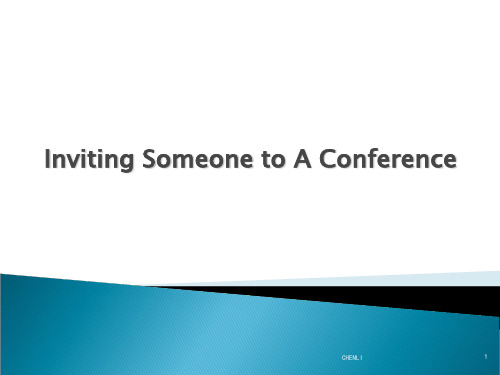
CHENLI
13
再次邀请、期望出席
(1)I look forward to yourБайду номын сангаасparticipation in the GaETC 2004 Conference.
(2)Please do not hesitate to let me know if you have any concerns and/or suggestions. Your contribution to this symposium would definitely benefit all the participants.
Please send us your lecture title and outline, along with related handouts(分发的 材料),before February 28, 1994. We will then
CHENLI
7
have a sufficient amount of time to make copies and appropriate arrangements. I also need your curriculum vitae(履历,简历), with contents to include: NAME, DATE OF BIRTH, PLACE OF BIRTH, NATIONALITY, MARITAL STATUS(婚姻状况),ACADEMIC QUALIFICATIONS(学 术资格),PROFESSIONAL EXPERIENCE(工作经历), SCIENTIFIC ACHIEVEMENTS(科研成就),CURRENT SCIENTIFIC ACTIVITIES, OTHER SCIENCE-RELATED ACTIVTIES, AND SELECTED
英文文献报告PPT模板
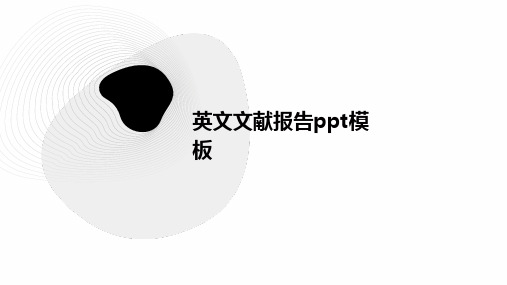
Detailed introduction to the experimental
02
design and implementation process of theme
three
03
Evaluate the experimental results and
conclusions of Topic Three
Research field
Covering multiple disciplines such as biology, chemistry, physics, etc., mainly focusing on the application and progress of XXX theme in various fields.
STEP 03
This can include the position, unit, or school name of the reporter.
If necessary, you can add your contact information or email address below your name.
英文文献报告ppt模 板
• cover • catalogue • Literature review • research method • Research findings and discussions • conclusion • References • Thanks
目录
Part
01
Theme Four
01
Introduce the research field and current situation of Topic Four
会议论文相关报告英文版.pptx
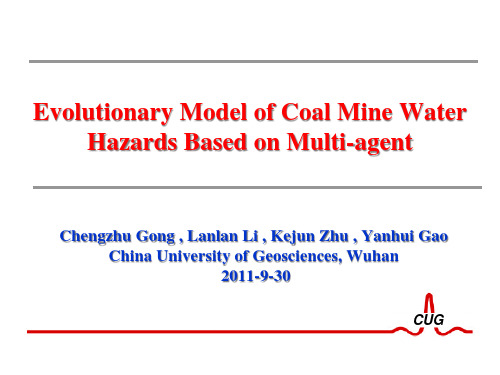
。2020年9月22日星期二下午4时0分57秒16:00:5720.9.22
• •
T H E E N D 15、会当凌绝顶,一览众山小。2020年9月下午4时0分20.9.2216:00September 22, 2020
16、如果一个人不知道他要驶向哪头,那么任何风都不是顺风。2020年9月22日星期二4时0分57秒16:00:5722 September 2020
parameters will simulate differsults
Curve Explain
curve ① water-richness of the mine; curve ② intercepting effect of water-proof layer. curve ③ risk levels of water in mining areas. curve ④ drainage ability of the mining area.
CUG
SIMULATION Results
Simulation situation Explain
(a) Safety mining condition (b) A better conditions of water proof layer
CUG
SIMULATION Results
Simulation situation Explain
-Coal mines are in complex hydro-geological conditions -Extension of coal mining depth -Coal demand constantly increasing
Prevention of coal water-inrush are renewed attention
国外PPT会议报告模板
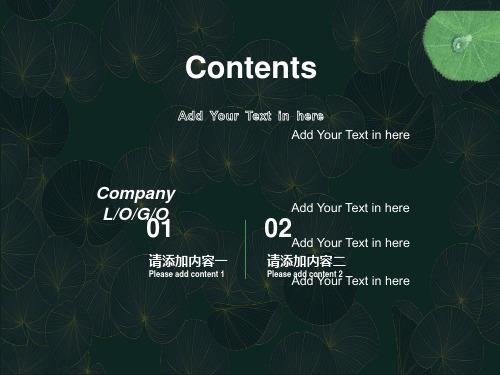
Title in here
Text in here
Text in here
Text in here
Text in here
Text in here
Text in here
Description of the contents
Click to edit title style
Click to edit title style
Click to edit title style
Title
Title
Title
Title
Title
Title
Title
Click to edit title style
Description of the contents
Level 5
Click to edit title style
Click to edit title style
Sub Department
Sub Department
Sub Department
Sub Department
CEO
Text in here
Text in here
Text in here
Title 01
Title
Title
Title
Title
Title
Description of the contents
Click to edit title style
20.4%
Description of the company’s products
Business Area
Business Area
英文学术报告ppt模板
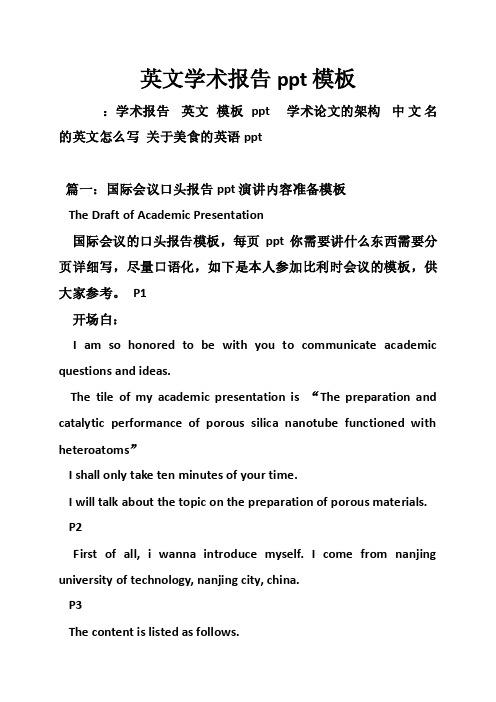
英文学术报告ppt模板:学术报告英文模板p pt 学术论文的架构中文名的英文怎么写关于美食的英语ppt篇一:国际会议口头报告ppt演讲内容准备模板The Draft of Academic Presentation国际会议的口头报告模板,每页ppt你需要讲什么东西需要分页详细写,尽量口语化,如下是本人参加比利时会议的模板,供大家参考。
P1开场白:I am so honored to be with you to communicate academic questions and ideas.The tile of my academic presentation is “The preparation and catalytic performance of porous silica nanotube functioned with heteroatoms”I shall only take ten minutes of your time.I will talk about the topic on the preparation of porous materials. P2First of all, i wanna introduce myself. I come from nanjing university of technology, nanjing city, china.P3The content is listed as follows.P4All our researches are conducted by the academic thoughts. Generally speaking, we are committed to porous materials. In order to explore high-performance functionalized materials for Pilot experiments and scale-up production; we tune the structure, such as composition and morphology step by step and optimize them further. What’s more, the possible synthesis mechanisms are also investigated. Today, the presentation is based on the right-hand branch.P5It is known that mesoporous silica have excellent characters as the catalyst carrier, such as……..But due to lack of active sites, we have to introduce organic or inorganic species as active sites. And the catalytic performance need to be further improved.P6As we know, the three factors including activity, scale and diffusion factor play decisive role in the catalysis, affecting the yield, selectivity, stability strongly. In our presentation, we mainly focus on the influence of scale factor on the catalysis.P7Due to lack of active sites for mesoporous silica, two mainmethods (surface loading, modified framework) are widely reported, by which various organic or inorganic active sites can be immobilized on the surface or incorporated into the framework of mesopoous silica.P8Though various morphologies of mesoporos silica were widely synthesized, the synthesis of the mesoporos silica, with three simultaneous characteristics including doped metal, mesoporous structure and specific morphology, is always a challenge, which is rarely reported.In other words, for our case exploring a proper condition, at which the silicon and metal sources can simultaneously hydrolyze, can ensure a desired material.P9Next, let’s look at the synthetic steps. Firstly,…. Then, …. After that, …. At last, we obtained theproducts.P10In this work, by changing the synthesis conditions, such as …, and so on, the pure mesoporous silica with different morphologies were synthesized, including nanosphere, nanorod, helix, capsule and nanotube. We will focus on the preparation and catalyticapplication of mesoporous silica with nanotube morphology.P11the SEM images of samples: A1, A2, A3 are shown in the figure. It can be seen that sample a1 is nanowire-like with length of about 2μm and diameter of about 100nm. When the amount of ... is 0.04 g, the morphology of sample A2 became to be short and thick rods and the size is about 1μm in length and 400nm in diameter, respectively. With further increasing the amount of ..., the sample A3 and A4 turned to be spherical morphology. It also can be seen that the diameters of samples A3 and A4 are substantially the same about 450nm. However, the spherical morphology of A4 is more regular than that of A3.The XRD patterns showed four reflection peaks attributed to (100), (110), (200) and (210), respectively, due to the hexagonal sructure. P12Then, we keep the same amount of ..., increasing the amount of .... We found that the length increased gradually. The XRD patterns also showed the hexagonal sructure of samples B1, B2, B3, B4.P13Moreover, an additional proof of the hexagonal symmetry structure is given by TEM and the FT pattern. The N2 adsorption-desorption isotherms of the samples B1, B2, B3, B4exhibit a typical type-IV isotherm.According to the table of structural parameters, we can find that the specific surface area and total pore volume increase gradually, the thickness of wall decrease and there is no obvious change in diameter.P14Furthermore, the possible synthesis mechanism of the mesoporous silica nanotube in dual templates system was proposed. We suggest that due to electrostatic repulsion between positively charged ammonium ions from hydrated ammonia molecules and hydrophilic groups of ..., especially in ammonia (NH3, 25wt.%) solution, the high concentrated ammonium ions provide a crowded and repulsive space to prevent the conjunction of ... molecules, leading to the formation of the rod-like micelles as template to form pore structure instead of sphere-like ones.The role of co-template ... is suggested to tune the length of rod-like micelles by arranging itself along the axis of channel with PEO and PPO part immersed in the hydrophilic and the hydrophobic group of CTA+ respectively. As a result, the mesoporous nanotube with different length will be synthesized. However, the non-polar ... micelles are not affected by positively charged ammonium. When the amount of co-template increased further, the non-polar ... micelles tend to control themorphology of micelles which are sequentially from nanotube, short rod to sphere-like ones. It my be the reason that the non-polar ... micelles would provide stronger attractive force than the electrostatic repulsion derived from the PEO block, ammonium ions and head group of ..., respectively.P15In order to investigate the influence of the morphology and structure of mesoporous silica on catalyticperformance, the samples with copper incorporated were synthesized.P16The figure shows the SEM and TEM images of samples a1, a2, a3, from which we can see they represent incremental length in the range of about 0.5, 1.0 and 1.5μm, and insignificant change in diameter around 100nm. In XRD patterns, there are also four reflection peaks for the samples with copper incorprated, respectively, which indicates the incorporation of the inorganic copper salt has no obvious effect on the hexagonal sructure and the ordered degree of pore structure. Moreover, the trends in length and the diameter of nanotube are illustrated.P17The N2 adsorption-desorption isotherms of the samples a1, a2, a3exhibit a typical type-IV isotherm according to the IUPAC classification and no hysteresis loop at the relative pressure range of 0.2≤p/p0≤0.4, implying the samples not only have ordered mesoporous structure but also the uniform pore size. Moreover, the pore diameters did not change significantly at different weight ratio of .../.... The most probable pore sizes of samples a1, a2, a3 are determined to be 2.71, 2.50, 2.44 nm, respectively. The structural parameters are listed in following table.P18This table summarized the catalytic activity of copper-modified porous silica nanotube in the direct hydroxylation of benzene with H2O2 as oxidant. The catalysts showed high catalytic activity, and direct proportional relationship between the benzene conversion and the length of the silica nanotube. Considering the similar copper content determined by ICP, the variations of catalytic activities were probably caused by different retention time of reagent in the nanotube with different lengths. P19It is Summary and Future ResearchThis part of research can be summed up from the following three aspects.Mophology control,Catalytic activity and Future research看this slide.P20thanks篇二:英文PPT开场成功英语演讲的秘诀:开场白、结束语应对问题-I will be pleased to answer any questions you may have at the end of the presentation. -Please can you save your questions till the end.-If you have any questions, I will be pleased to answer them at the end of the presentation. -there will be time at the end of the presentation to answer your questions-so please feel free to ask me anything then.-Don't hesitate to interrupt if you have a question.-Please feel free to interrupt me at any time.-Please stop me if you have any questions.-If you need clarification on any point, you're welcome to ask questions at any time. -Can I come back to that point later?-I will be coming to that point in a minute.-That's a tricky question.-We will go into details later. But just to give you an idea of...-I am afraid there's no easy answer to that one...-Yes, that's a very good point.-Perhaps we could leave that point until the questions at the end of the presentation -I think I said that I would answer questions at the end of the presentation---perhaps you wouldn't mind wait ing until then.-I think we have time for just one more question欢迎听众(正式)- Welcome to our company- I am pleased to be able to welcome you to our company...- I'd like to thank you for coming.- May I take this opportunity of thanking you for coming欢迎听众(非正式)- I'm glad you could all get here...- I'm glad to see so many people here.- It's GREat to be back here.- Hello again everybody. Thank you for being on time/making the effort to come today. - Welcome to X Part II.受邀请在会议上致词- I am delighted/pleased/glad to have the opportunity to present/of making this presentation...- I am grateful for the opportunity to present...- I'd like to thank you for inviting/asking me/giving me the chance to...- Good morning/afternoon/evening ladies and gentleman- It's my pleasant duty today to...- I've been asked to...告知演讲的话题- the subject of my presentation is...- I shall be speaking today about...- My presentation concerns...- Today's topic is...- Today we are here to give a presentation on...- Today we are here to talk about...Before we start, I'd like you meet my team members... - A brief look at today's agenda...(告诉听众所讲内容的先后顺序)- Before we start our presentation, let's take a brief look at the agenda...- I shall be offering a brief analysis of...- the main area that I intend to cover in this presentation is...- Take a moment and think of...- Thank you for giving me the opportunity to tell you about...告诉听众发言的长度- During the next ten minutes, I shall...- I shall be speaking for about ten minutes...- My presentation will last for about ten minutes...- I won't take up more than ten minutes of your time...- I don't intend to speak for longer than ten minutes...- I know that time is short, so I intend to keep this brief- I have a lot to cram in to the next ten minutes, so I'd better make a start...引起听众的兴趣- I'm going to be speaking about something that is vitally important to all of us. - My presentation will help solve a problem that has puzzled people for years...- At the end of this presentation you will understand why this company has been so successful for so long...- I am going to be talking about a product that could double your profit margins... - the next ten minutes will change your attitude to sales and marketing...- Over the next ten minutes you are going to hear about something that will change the way your companies operate...- By the end of this presentation you will know all there is to know about...告诉听众内容要点- there are five main aspects to this topic (...the first, ... the second, ...a third, ...another, ... the final)- I am going to examine these topics in the following order(...first, ...next, ...after that, ...finally)- I've divided my talk into five parts...- I will deal with these topics in chronological order...- I'm going to start with a general overview and then focus on this particular problem (...in general, ...more particularly).- I want to start with this particular topic, and then draw some more general conclusions from it (...specifically, ... in a wider context).- there are (a number of) factors that may affect...- We have to take into account in any discussion of this subject, the followingconsiderations.- We all ought to be aware of the following points.结束语-In conclusion, I'd like to...-I'd like to finish by...-Finally...-By way of conclusion...-I hope I have made myself understood-I hope you have found this useful-I hope this has given you some idea/clear idea/an outline of...-Let me end by saying...-That, then was all I had to say on...-That concludes our presentation...-I hope I've managed to give you a clearer picture of...-If there are any questions, I'd be delighted to...-Thank you for your attention...-Let's break for a coffee at this point-I am afraid that the clock is against us, so we had better stop here -You have been a very attentive audience---thank you转自http:///abc/html/kouyujicui/20070821/4.html转帖二做presentation,我们要注意对话题的准备以及态度和身体语言等等,除此之外,我们还应该掌握一些常用句型。
学术论文写作报告(英文版)
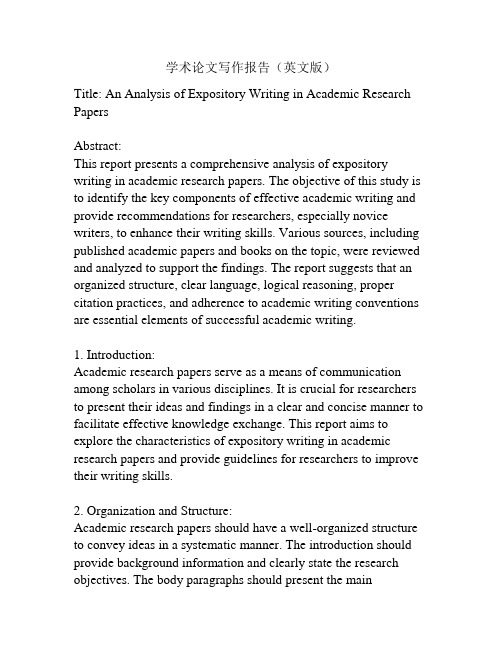
学术论文写作报告(英文版)Title: An Analysis of Expository Writing in Academic Research PapersAbstract:This report presents a comprehensive analysis of expository writing in academic research papers. The objective of this study is to identify the key components of effective academic writing and provide recommendations for researchers, especially novice writers, to enhance their writing skills. Various sources, including published academic papers and books on the topic, were reviewed and analyzed to support the findings. The report suggests that an organized structure, clear language, logical reasoning, proper citation practices, and adherence to academic writing conventions are essential elements of successful academic writing.1. Introduction:Academic research papers serve as a means of communication among scholars in various disciplines. It is crucial for researchers to present their ideas and findings in a clear and concise manner to facilitate effective knowledge exchange. This report aims to explore the characteristics of expository writing in academic research papers and provide guidelines for researchers to improve their writing skills.2. Organization and Structure:Academic research papers should have a well-organized structure to convey ideas in a systematic manner. The introduction should provide background information and clearly state the research objectives. The body paragraphs should present the mainarguments in a logical and coherent way, supported by relevant evidence. Finally, the conclusion should summarize the findings and provide implications for further research.3. Clarity of Language:Clear and concise language is fundamental in academic writing. Researchers should aim to convey their ideas in a straightforward manner, avoiding jargon and unnecessary complexity. Using simple and precise language helps readers understand the content more easily and efficiently.4. Logical Reasoning:Academic research papers should exhibit a clear and logical flow of thoughts and arguments. Each paragraph should be logically connected to the previous and following ones, and the overall structure should guide readers through the research process. Using appropriate transitions and connecting phrases can improve the coherence and readability of the paper.5. Citation Practices:Proper citation practices are crucial in academic writing to acknowledge the contributions of other researchers and avoid plagiarism. Researchers should meticulously cite all the sources they have referred to using a recognized citation style, such as APA or MLA. Failure to properly cite sources can result in academic dishonesty and reputational damage.6. Adherence to Academic Writing Conventions:Academic writing follows specific conventions, such as using the third person, avoiding personal opinions, and maintaining a formaltone. Researchers should familiarize themselves with these conventions and ensure their papers adhere to them to maintain the integrity and credibility of their research.7. Conclusion:Effective academic writing requires attention to various elements, including the organization and structure of the paper, clarity of language, logical reasoning, proper citation practices, and adherence to academic writing conventions. Novice researchers can benefit from understanding and implementing these key components, ultimately enhancing the quality and impact of their research papers. Continuous practice and seeking guidance from experienced researchers can further improve their writing skills. 8. Recommendations:To further improve academic writing skills, researchers should actively engage in peer-review processes, attend writing workshops and conferences, and seek feedback from their mentors and colleagues. Writing groups and online forums dedicated to academic writing can also provide valuable support and guidance. In conclusion, this report highlights the importance of expository writing in academic research papers and provides recommendations for researchers to enhance their writing skills. By adhering to the identified key components, novice researchers can produce high-quality academic papers that contribute to the advancement of knowledge in their respective fields.9. Key Components of Effective Academic Writing:9.1. Organization and Structure: A well-organized structure is a key component of effective academic writing. It helps readersnavigate through the research paper and understand the flow of ideas. Researchers should ensure that their papers have a clear and logical structure, including an introduction, body paragraphs, and a conclusion. The introduction should provide the necessary background information and context for the research, as well as clearly state the research objectives. The body paragraphs should present the main arguments or findings supported by relevant evidence and analysis. Finally, the conclusion should summarize the key findings and provide implications for future research.9.2. Clarity of Language: Clarity of language is crucial in academic writing. Researchers should strive to communicate their ideas in a clear and concise manner to ensure that readers can easily understand the content. The use of jargon and unnecessary complexity should be avoided. Instead, researchers should use simple and precise language to convey their ideas effectively.9.3. Logical Reasoning: Logical reasoning is a fundamental component of academic writing. Researchers should present their arguments in a logical and coherent manner, providing evidence and analysis to support their claims. Each paragraph should flow logically from one idea to the next, and there should be a clear connection between different sections of the paper. The use of appropriate transition words and phrases can help improve the coherence and readability of the paper.9.4. Proper Citation Practices: Proper citation practices are essential in academic writing to acknowledge the contributions of other researchers and avoid plagiarism. Researchers should carefully and accurately cite all the sources they have referred to intheir papers. This includes both in-text citations and a comprehensive reference list at the end of the paper. Different citation styles, such as APA, MLA, or Chicago, have specific guidelines that researchers should follow. Failure to properly cite sources can have serious consequences, including academic misconduct and damage to one's reputation.9.5. Adherence to Academic Writing Conventions: Academic writing follows certain conventions and standards that researchers need to adhere to. These conventions include using the third person, maintaining a formal tone, and avoiding personal opinions unless specifically requested in certain types of papers, such as opinion or reflection pieces. Researchers should familiarize themselves with the specific conventions of their field or discipline and ensure that their writing aligns with these expectations. Adhering to academic writing conventions helps maintain the integrity and credibility of the research.10. Recommendations for Enhancing Academic Writing Skills: 10.1. Seek Peer Review: Peer review is a valuable process for improving academic writing skills. Researchers should actively seek feedback from their peers and colleagues. They can join writing groups or engage in peer review exchanges to receive constructive criticism and suggestions for improvement. Peer review provides an opportunity to identify areas of weakness or confusion in the writing and make necessary revisions.10.2. Attend Writing Workshops and Conferences: Writing workshops and conferences offer researchers the chance to learn from experts in the field and gain insights on effective academicwriting techniques. These events often provide practical tips, strategies, and resources for improving writing skills. Researchers should take advantage of these opportunities to enhance their writing abilities.10.3. Seek Feedback from Mentors and Colleagues: Seeking feedback from experienced mentors and colleagues can be incredibly helpful in improving academic writing skills. These individuals can provide valuable insights and guidance based on their own experiences. Researchers should actively seek their feedback on drafts and revisions to refine their writing.10.4. Practice Regularly: Like any skill, academic writing requires regular practice to improve. Researchers should set aside dedicated time for writing and make it a habit. Regular practice allows researchers to develop their own writing style, become more comfortable with academic writing conventions, and refine their ability to convey complex ideas clearly.10.5. Utilize Writing Resources: Various writing resources are available to researchers to enhance their writing skills. Academic writing books, online tutorials, and writing guides can provide guidance on grammar, style, and organization. Researchers should take advantage of these resources to expand their knowledge and improve their writing.10.6. Seek Guidance from Writing Centers: Many universities and institutions have writing centers or writing support services that offer individualized assistance to researchers. These centers provide guidance on various aspects of academic writing, such asstructure, language, and citation practices. Researchers should utilize these resources to receive specialized support and feedback on their writing.In conclusion, effective academic writing requires attention to various key components, including organization and structure, clarity of language, logical reasoning, proper citation practices, and adherence to academic writing conventions. Novice researchers can enhance their writing skills by implementing these components and by actively seeking feedback, participating in workshops, and practicing regularly. With time and effort, researchers can improve their ability to communicate their ideas effectively through well-crafted academic research papers.。
英文文献汇报PPT模板

Entrepreneurial orientation(创业导向) E: Institutional Pressure(机构压力)
2 Research Hypothesis
Apart from the general TOE factors that are used in previous studies, interactivity(交互性) and entrepreneurial orientation(创业导向) were also considered as important factors in social media usage and thus included in the study.
(2)The compatibility of social media was identified as a significant factor that is positively associated with social media usage in organizations. Anyone with an Internet connection can use social media.
on the important factors that are positively associated with social media usage. Moreover, this study reports the various purposes for which the social media can be used successfully. Organizations can
社交媒体 交流与沟通 顾客需求 影响因素
外文文献汇报PPT模板
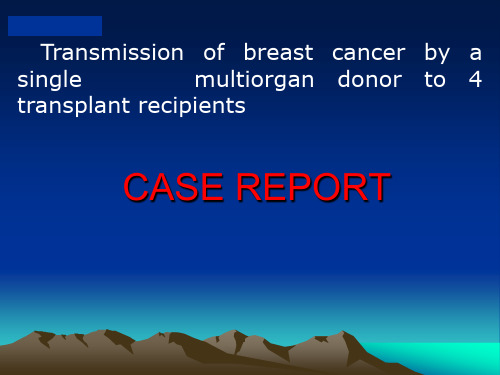
④、Right-kidney recipient
A 32-year-old male received the right kidney. After he was informed of the transmission of breast cancer to the lung recipient in 2010, regular tumor screening investigations were performed, including achest X-ray and ultrasound of the abdomen. In addition, a CT scan of the chest was performed in January 2011. All of the findings were unremarkable.
Why would a person who shows no signs of cancer "infect" organ recipients after an organ transplant? Why do patients with different organs have the same kind of cancer? At present, the researchers have only some speculation about the cause, the definitive reason is unknown. One hypothesis is that donor breast cancer has metastasized or metastasized in every transplant organ, and previous studies have shown that circulating tumor cells were found in the first stage of breast cancer. Recipients of organ transplants require long-term use of immunosuppressants, which allow cancer cells in organs that do not normally develop. Another possible reason is that ischemia-reperfusion in10jury
英文文献汇报 ppt课件

equation modeling, which allows the researcher to find the empirical evidence by testing
a measurement model and a structural model. The model comprised three variables, self-
purpose of this cross-sectional study was to test the multidimensional
assumptions of quality of life of patients with cancer, with focus on their self-
现有文献表明,自我控制能够克服癌症幸存者康复中的病理症状或问题,它还作为
身体残疾导致日常活动受限的患者的缓冲和心理资源,自我控制构成了信念和积极行为, 这种信念与生命可以用自己的意志和努力来领导有关,并且在各种压力情况下对保护和 促进身心健康起着重要作用。
加强自我控制的干预措施,将有助于改善生活质量。
2020/12/27
8
literature1--Reading comprehension(阅读感悟)
该研究通过确接受化疗的癌症患者的CIPN程度、控制感和生活质量之间的因果关系, 从而得出化疗的癌症患者的自我控制对CIPN引起的生活质量有很大的改善与提高。自我 控制被认为是控制自己的功能和行为,作为一个人的功能的核心,并在人生成功中起着 举足轻重的作用。
inadequate pain management and to generate solu-tions for closing the gap between the
- 1、下载文档前请自行甄别文档内容的完整性,平台不提供额外的编辑、内容补充、找答案等附加服务。
- 2、"仅部分预览"的文档,不可在线预览部分如存在完整性等问题,可反馈申请退款(可完整预览的文档不适用该条件!)。
- 3、如文档侵犯您的权益,请联系客服反馈,我们会尽快为您处理(人工客服工作时间:9:00-18:30)。
Chengzhu Gong , Lanlan Li , Kejun Zhu , Yanhui Gao China University of Geosciences, Wuhan 2011-9-30
Water-inrush principle & Energy accidental release & Human error theory
Unsafe acts
· Drilling · Mining
Unsafe conditions
· Water accumulation · Channels activation
CUG
CONTENTS
Introduction Evolutionary model of coal mine water hazards Simulation with NetLogo Conclusions
CUG
INTRODUCTION
Coal water-inrush accidents increasing
Agents interactive in the model.
Drainages Agent
CUG
SIMULATION Processes
Simulation platform : NetLogo Parameters setting
-Water sources rank : [0-5] -Channel permeability : [0-1] -Mining activity: #workers*N -Drainage ability: base on water volume -Iterations:5000
CUG
SIMULATION Processes
Simulation interfaces in NetLogo
Tchwaonndeiml aernesaio、nmalianrineag
is divided into four parts: water area、 activity area & drainage area. Change
Waterheads Agent
Mining activities Agent
Prevention measures
Interaction in population
ห้องสมุดไป่ตู้
System boundary
Feedback mechanism
Population evolution
Channels Agent
-Water bursting coefficient 、Vulnerability index method -Critical layer analysis、Fault tree analysis -GIS、DC、TEM & Information fusion analysis
CUG
INTRODUCTION
Evolution mechanism of coal water-inrush
Mining activities Hydrogeology Prevention technique
Incentive Waterhead Channels Drainage
Coal mining water hazards traits
Coal mining water hazards
Water Channel Mining activities Drainage and emergency measures.
CUG
EVOLUTIONARY Model
Agent-based model of coal water-inrush
CUG
INTRODUCTION
Coal mine water hazard cognizance
-Is a complex and adaptive phenomenon -Possess nonlinear dynamic characteristics
Prevention methods of coal water-inrush
Water balance incontrollable
Drainage invalidation
Risk assessment
Prediction
Coal mine water hazards Formation
Prevention
Prevention technique
CUG
EVOLUTIONARY Model
-Coal mines are in complex hydro-geological conditions -Extension of coal mining depth -Coal demand constantly increasing
Prevention of coal water-inrush are renewed attention
Unreasonable drainage measures
· Minesump & Equipment overload · Technical defects, Management fault
Incentive
Energy liberation
Abnormal water inflow increase
Deficiency of the traditional method
-Failed to describe the nonlinear dynamic phenomena -Not studied on the view of system science
The creative points of the thesis
-Solving bycomplex systems theory &methods -Using Agent-based modeling and simulation(ABMS)
CUG
EVOLUTIONARY Model
Formation mechanism of coal water-inrush
